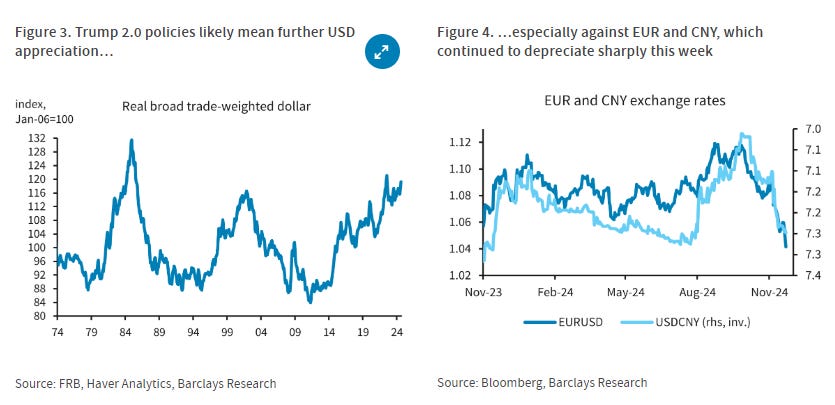Weekly Good Reads: 5-1-1
Euro-US Divergence, Global Strategy Outlook, US Financial Stability, Investing Lessons, BATNA, AI for Practice Exam
Welcome to a new issue of Weekly Good Reads 5-1-1 by Marianne, a 25-year investment practitioner writing about investing, economy, wellness, and something new I learned in AI/productivity.
In this Weekly, I share insightful/essential readings, charts, and one term, incorporating some of my market observations and weekly change tables. I look beyond data and share something enlightening about life, health, technology, and the world around us 🌍!
Sharing the quote of the week:
Gratitude turns what we have into enough, and more. It turns denial into acceptance, chaos into order, confusion into clarity...it makes sense of our past, brings peace for today, and creates a vision for tomorrow. ~ Melody Beattie
Weeklies archive | Investing | Ideas | Index of charts and terms
Conversations with Female Investors and more (to inspire more females into finance and investment careers 🙌.)
Here’s my latest post in case you have missed it:
👉 One more: here’s an invitation to try our digital investment software for creating customized portfolios tailored just for your goals and risk profile (for free):
Market and Data Comments
The biggest macro news this past week was in foreign exchange, as the Euro dropped 1.2% versus the US Dollar during the week following the news of the contractionary Euro Area PMI (48.1 vs. 50 in Oct) led by weakness in manufacturing, and the prospect of US tariffs (Europe has large external trade) and the US economic resiliency.
The interest rate differential between the US and the Euro could widen as the ECB may need to cut 50bp in December to counter its economic weakness, while the Fed may slow down the pace of rate cuts next year due to economic growth and tariffs implementation, which can boost inflation.
Trump’s trade policy could also inflict more pain on emerging countries as they may have to slow down rate cuts to counter their weakening currencies in the face of a stronger dollar if the aggressive Trump tariffs are implemented. According to Bloomberg, the hardest-hit countries are seen in Latin America (the Northeast quadrant shows the countries that are hardest hit by higher US interest rates and tariffs.)
Talking about vulnerabilities, the Fed has just released its annual Financial Stability Report (see Econ/Invest #3), assessing vulnerabilities from these 4 categories:
Elevated asset valuations across equity, corporate bond, and property markets, with low liquidity contributing to volatility.
Moderate vulnerabilities from borrowing by businesses and households with total debt trending down albeit business leverage and delinquencies among nonprime borrowers were elevated.
Notable leverage in the financial sector, with banks resilient but exposed to interest rate risks and hedge fund leverage at or near decade highs (see table below showing the banks’ fixed asset portfolios were over $500 billion below their book value).
Lower but still notable funding risks, with banks reducing uninsured deposits but increasing wholesale funding, while vulnerabilities persisted in money market and bond funds.
Another noteworthy earnings report was from Nvidia, which recorded a 94% quarter-over-quarter revenue growth (+112% growth in data-centre demand) and a net profit of $20 billion, which doubled from a year ago. CEO Jensen Huang indicated confidence in beating next year’s analyst revenue growth forecast at 54% due to the great demand for its latest Blackwell chip. AI Agents and longer-thinking AI (test-time compute) are new drivers of AI demand. Its unique culture probably makes the company a rare breed (see Econ/Invest.)
Nevertheless, the US stock market rally continues to broaden to other sectors than the “Magnificent Seven” stocks. The above chart shows the relative valuation between the S&P 500 index and an equal-weighted S&P 500 index (SPXEWTR Index, the underlying index of the ETF: RSP), which is a cheaper play on the S&P index stocks.
For 2025, the below summarizes neatly Morgan Stanley’s outlook on various asset classes (categorized by regions and types of assets).
This coming week, we will monitor the November US FOMC meeting minutes on Tuesday, Q3 real GDP, October Personal Spending, and October core PCE on Wednesday, Euro Area November inflation on Friday, and China November 1-year MLF rate on Monday.
Economy and Investments (Links):
What to Know About Scott Bessent, Trump's Treasury Pick (Axios)
Euro Risks Dropping to Parity Against Dollar as Economy Falters (WSJ)
Financial Stability Report (2024) (Federal Reserve)
+ How Jensen Huang Built Nvidia Into the $3 Trillion King of AI (Barron’s or via Archive)
Finance/Wealth (Link):
10 Investing Lessons from the 2024 Election (The Big Picture)
+ Cash as Trash—or King (Frank K. Martin, CFA)
Buffett’s “not-so-secret weapon,” as noted in the 2023 annual letter excerpt above, is to sell on good news so you have cash to buy on bad news. Only a tiny fraction of investors have the willpower to walk away from the table when they have a hot hand. The wealthiest diversified investor in the world advises: You can enjoy great investment success “if you make a couple of good decisions during a lifetime and avoid serious mistakes.”
Wellness/Idea (Link):
The Surprising Benefits of Talking Out Loud to Yourself (Time Health)
Talking out loud to yourself is perfectly normal—and even beneficial. It can facilitate problem-solving and improve how well you perform at a task…
Self-talk can be motivating, too, Lupyan points out. In one study, basketball players performed faster and better when they talked through their moves out loud in an encouraging or instructional way. It can also help keep you focused, especially in a situation that requires lots of different steps.
~ Gary Lupyan, a psychology professor at the University of Wisconsin-Madison who has researched self-talk
One Chart You Should Not Miss: Most Cited Potential Shocks for the US Over the Next 12 to 18 Months (New York Fed Survey)
In the Fed’s Financial Stability Report, the New York Fed surveyed various financial institutions from late August to late October of 2024 on the “Salient Risks to Financial Stability”.
“Concerns surrounding U.S. fiscal debt sustainability were atop the list in this survey, followed by escalating tensions in the Middle East and policy uncertainty, which was also frequently cited in the last survey (figure B ). Contacts also flagged the risk of a U.S. recession near the top of the list. The risk of persistent inflationary pressures and the implications of a restrictive monetary policy stance, which had been the top-cited risk in five out of the previous six surveys, including the last cycle, was less frequently cited this round. Respondents noted risks surrounding global trade more frequently this cycle than in the previous survey. A correction in risky asset prices as well as renewed stress in the banking sector, which were noted in the spring survey, continued to be cited but not as prominently. While not as frequently cited as other risks, further weakness in the Chinese economy and the potential for a cyberattack on a financial institution were seen as carrying some of the most severe consequences should either of them materialize.”
One Term to Know: BATNA
BATNA, the best alternative to a negotiated agreement, is a term coined by Roger Fisher and William Ury in their 1981 bestselling book "Getting to Yes: Negotiating Agreement Without Giving In".
Fisher and Ury were negotiation researchers at the Harvard Program on Negotiation (PON) who developed the concept of BATNA as part of their work on principled negotiation.
While it is important to aim high in negotiations, it is equally important to know when to walk away from a mediocre offer. Here are 4 steps to determine what your BATNA is in a negotiation:
List your alternatives. If your negotiation ends in an impasse, think about all available alternatives —what are your no-deal options?
Evaluate your alternatives, calculating the value of pursuing each one.
Establish your BATNA (before the negotiation begins). Select a course of action that would provide you with the highest expected value (your BATNA) - the course you should pursue if the current negotiation fails.
Calculate your reservation value. This is the lowest-valued deal you are willing to accept. If the value of the deal proposed to you is below your reservation value, you will be better off rejecting the offer and pursuing your BATNA and vice versa.
[🌻] Things I Learn About AI/Productivity:
How Bluesky, Alternative to X and Facebook, Is Handling Explosive Growth (New York Times)
+ 7 Things to Know About Bluesky Before You Join - And Why You Should (ZDNET)
I tested a practical use case of Gen AI: Using Anthropic Claude or any LLM to create mock or practice exams for notary public exams.
I recently took my California notary public renewal exam, and a great use case of LLM is to generate my own practice exam based on the California Notary Handbook (2024) and other relevant materials, especially related to notary fines and penalties, the most-quizzed areas of the notary public exam! Here are the questions I generated with answers supported by the California codes. You can use this to test yourself on any subject you want to learn. Another good LLM to use is Google’s NotebookLM (Study Guide).
Please do not hesitate to get in touch if you have any questions!
Please also check out my Conversations with female fund managers, wealth advisors, and more.
If you like this Weekly, please share it with your friends or subscribe to my newsletter🤝.












